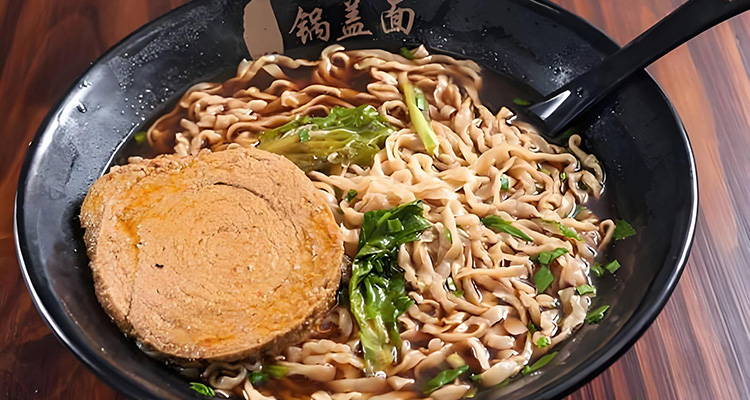Wuhu Knife Noodles: A Century of Jiangnan Flavor
1. Origin and History: A Knife-Cut Tradition
Little Knife Noodles originated in Wuhu, Anhui Province, during the late Qing and early Republican eras when the city thrived as a Yangtze River port. Dockworkers needed a quick, filling meal, so cooks combined high-gluten flour and alkaline water, rolled it into thin sheets, and sliced uniform strips with a broad, thin-bladed knife. The name “Little Knife Noodles” comes from this distinctive cutting method. Over a century, this breakfast staple moved from the docks into neighborhood noodle shops, becoming a living emblem of Wuhu’s mornings.
2. Cultural Meaning: A Breakfast of Longing and Home
For Wuhu locals, Xiaodao Mian is more than food. In small noodle shops, residents chat in dialect while slurping bowls, repeating a daily ritual. Many who leave Wuhu return expressly to enjoy a bowl—its springy texture reconnects them to childhood lane corners. In 2010, Little Knife Noodles were listed as part of Wuhu’s intangible cultural heritage, cementing their role in the city’s taste memory.

3. Ingredients: Simple, Precise, Essential
The noodle’s magic lies in simplicity: high-gluten wheat flour, a touch of alkaline water, and salt. Alkaline water improves elasticity and gives a pale yellow hue; salt amplifies the natural sweetness of the flour. Some traditional shops insist on local winter wheat from the Jianghuai Plain for higher protein and stronger dough. The final texture depends on exact flour-to-water ratios and careful handling.
4. Making Method: The Craft of Hand and Blade
“Knead three times until soft as cotton; cut steady as a mountain”—masters follow this mantra.
- Kneading: The rested dough is repeatedly thrown and folded until satin-smooth, often taking over half an hour until it can stretch into a thin film.
- Cutting: The most theatrical step. Thin-rolled sheets are layered, then sliced with a long, wide knife. Noodles fall like snowflakes, each strip 2–3 mm wide.
- Cooking: Boiled in rolling water, noodles are pulled out as soon as they float—usually under a minute—to retain ideal chewiness.

5. Flavor and Texture: Chew, Slide, Savor
A well-made bowl balances chewiness, silkiness, and a refreshing bite. Hand-kneading develops gluten for a springy, non-starchy chew; alkaline water adds subtle savor and wheat aroma with a pleasant aftertaste. In Wuhu, many pair the noodles with a rich red broth made from pork bones and chicken frames, which highlights the pure noodle flavor.
6. How to Eat: Soup or Tossed, Your Choice
Little Knife Noodles can be served in broth or dressed:
- Soup: The classic choice. Purists enjoy clear broth; others prefer richer red broth flavored with soy, lard, and scallions, topped with a poached egg or braised tofu.
- Tossed: Popular in summer—noodles are chilled and mixed with sesame paste, chili oil, and vinegar for a bright, refreshing bite.
Locals often pair a bowl with soup dumplings or sesame flatbreads for a complete breakfast experience.
7. Where to Try: Local Morning Map
For authentic bowls, visit old-town noodle shops before 6–8 AM. Recommended spots include areas near Shuangtong Alley (Shuangtong Xiang) and Fuluo Mall (Fuluo Shangcheng). Ask for a slightly undercooked finish (“al dente”) if you prefer more bite. If concerned about salt, request a milder broth and enjoy pickled local vegetables on the side.
8. Visitor Tips: Join the Morning Ritual
- Language: Order “red broth” or “white broth” for broth type; call the tossed version “dry” or “mixed.”
- Hidden items: Many shops offer half-noodle/half-wonton options—try both.
- Cultural experience: Watch the cutter’s technique or book a hands-on kneading lesson at select shops (advance booking advised).
- Best seasons: Spring and autumn are ideal; choose tossed noodles in summer and soup in winter.
9. Home Version: A Simple Family Recipe
To replicate at home:
- Mix 200 g all-purpose flour, 2 g alkaline water, and 3 g salt; add water gradually and knead until smooth. Rest 30 minutes.
- Roll thin, dust with starch to prevent sticking, fold, and slice thin strips with a knife.
- Boil for about 1 minute, drain, and serve with chicken broth or a sauce of soy, rendered pork fat, and scallions. It won’t match a master’s dough, but it captures the essence.


